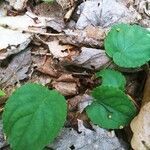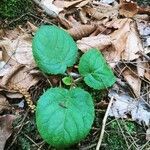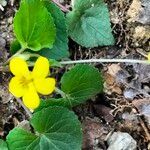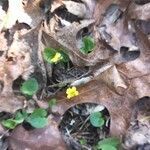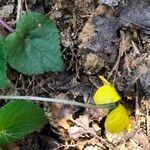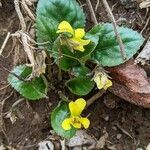Plants perennial, acaulescent, not stoloniferous, 1–20 cm; rhizome thick, fleshy. Leaves basal, 2–5, prostrate to ascending, often overlapping basally; stipules linear-lanceolate, margins entire, apex acute; petiole 2–8 cm, pubescent; blade unlobed, orbiculate, reniform, or ovate, 2–12 × 1.5–9 cm, base cordate, margins crenate to serrate, sometimes glandular, ciliate or eciliate, apex rounded to acute, surfaces usually pubescent throughout or concentrated proximally on both surfaces. Peduncles 1.5–7 cm, usually pubescent. Flowers: sepals lanceolate to ovate, margins ciliate or eciliate, auricles 0.5–1 mm; petals deep lemon-yellow on both surfaces, lower 3 brownish purple-veined, lateral 2 bearded, lowest 8–11 mm, spur yellow, gibbous, 1–2 mm; style head beardless; cleistogamous flowers on prostrate or partially subterranean rhizomes or on racemelike, nonrooting, and usually leafless branches growing from rhizome apex. Capsules ellipsoid, 5–10 mm, glabrous. Seeds beige, 1–2 mm. 2n = 12.
More
Acaulescent; rhizome elongate, covered with persistent lf-bases; lvs at anthesis broadly cordate-ovate, 2–3 cm, nearly as wide, finely undulate-crenate, their petioles with crisp hairs often extending onto the lower part of the blade; blades enlarging in summer to 5–12 cm, orbicular-ovate, with strongly cordate base and overlapping basal lobes; fls developing with the lvs, on rather short peduncles, bright yellow, the 2 lateral pet bearded, the 3 lower with brown veins; style clavate and abruptly capitate; cleistogamous fls on short, lfless stolons, appearing racemose; fr ellipsoid, 5–8 mm; seeds ivory; 2n=12. Deep, rich, usually coniferous woods; se. Que. and Me. to sw. Ont., s. to Pa., N.J., Del., and along the mts. to S.C. and Ga. Apr., May.
